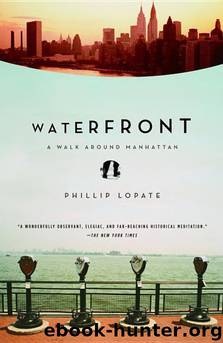Waterfront: A Walk Around Manhattan by Phillip Lopate

Author:Phillip Lopate [Lopate, Phillip]
Language: eng
Format: epub
Tags: Literary Collections, Essays, Biography & Autobiography, General
ISBN: 9780307492968
Google: QR69izwr9dcC
Amazon: B001O1O6M2
Publisher: Anchor
Published: 2008-12-17T16:00:00+00:00
16 EXCURSUS SAILORS AND MERCHANT SEAMEN IN NEW YORK
Arm in arm they careened up Pearl Street under the drenching rain. Bars yawned bright to them at the corners of rainseething streets…. Laplander Matty stood with his arms round two girls'necks, yanked his shirt open to show a naked man and a naked woman tattooed in red and green on his chest, hugging, stiffly coiled in a seaserpent….
—JOHN DOS PASSOS, Manhattan Transfer
THE SAILOR IS A LIMINAL FIGURE. HE PASSES BETWEEN SEA AND LAND WITHOUT EVER FULLY COMMITTING TO EITHER. WHEN IN PORT, HE OFTEN REQUIRES ANOTHER liquid (alcohol) to console him for the loss of his mother element. A risk to others, he is even more a danger to himself; and those who do not fear his approach—tavernkeepers, streetwalkers, shipping agents—systematically take advantage of him.
The working waterfront is at once a site of cleansing and defilement. In most religions, water purifies, renews, and washes away sins. (Followers of Shinto, Yoruba-influenced Baptists, Zoroastrians, Hindus, Christians, Jews, Muslims, and Native Americans all perform rites today around New York City's rivers.) On the other hand, only the truly amphibious may pass without harm from one medium to the other. “Danger lies in transitional states, simply because transition is neither one state nor the next, it is undefinable,” writes the anthropologist Mary Douglas. Waterfront districts have been traditionally associated with sin and peril. A port, no less an authority on the transgressive than Michel Foucault informs us, in Discipline and Punish, “is—with its circulation of goods, men signed up willingly or by force, sailors embarking and disembarking, diseases and epidemics—a place of desertion, smuggling, contagion: it is a crossroads for dangerous mixtures, a meeting place for forbidden circulations.”
The experience of sailors and seamen in New York Harbor is an essential part of the waterfront's history. Though the terms “sailor” and “seamen” often get used interchangeably, and mariners have frequently exchanged one role for the other, we might say for purposes of definition that the merchant seaman signs on with a commercial enterprise, while the naval sailor enlists in a military organization.
Of course, sailors did not always enlist. When New York was still a colony, the British navy would send armed press-gangs to enter houses and taverns and seize local men, whether they had seafaring experience or not, to fill its manpower needs—a practice known as impressment. The British navy had been losing recruits steadily to privateering, a more lucrative affair, especially during the French and Indian War. But impressment was so hated that those targeted for it would often run for their lives, or put up a struggle, and little boys would bombard the press-gangs with stones. Historian Jesse Lemisch has argued that these violations of sailors' civil liberties, and the sometimes violent resistance they provoked, laid the groundwork for the American Revolution. In his book Jack Tar vs. John Bull: The Role of New York's Seamen in Precipitating the Revolution, Lemisch demonstrates that during the Stamp Act riots, the mobs in New York were
Download
This site does not store any files on its server. We only index and link to content provided by other sites. Please contact the content providers to delete copyright contents if any and email us, we'll remove relevant links or contents immediately.
Crazy Rich Asians by Kevin Kwan(9171)
How to Bang a Billionaire by Alexis Hall(8075)
Giovanni's Room by James Baldwin(7199)
Little Fires Everywhere by Celeste Ng(7116)
Win Bigly by Scott Adams(7097)
Tease (Temptation Series Book 4) by Ella Frank(5593)
Pachinko by Min Jin Lee(5590)
The Fire Next Time by James Baldwin(5251)
The Perks of Being a Wallflower by Stephen Chbosky(4575)
China Rich Girlfriend by Kwan Kevin(4499)
Bluets by Maggie Nelson(4478)
First Position by Melissa Brayden(4449)
The Sympathizer by Viet Thanh Nguyen(4307)
Rich People Problems by Kevin Kwan(4246)
A Little Life (2015) by Hanya Yanagihara(4175)
Right Here, Right Now by Georgia Beers(4129)
Walking by Henry David Thoreau(3897)
Catherine Anderson - Comanche 03 by Indigo Blue(3568)
The Death of the Heart by Elizabeth Bowen(3554)
